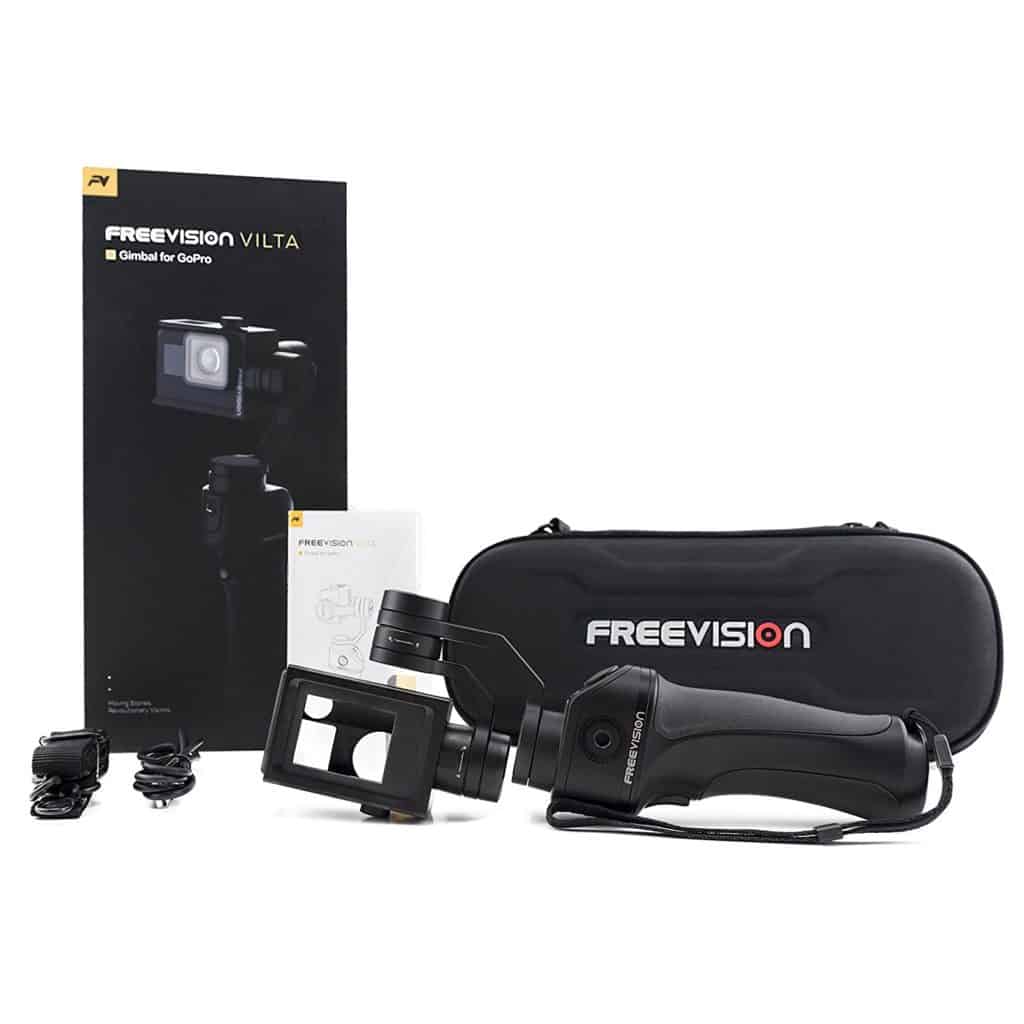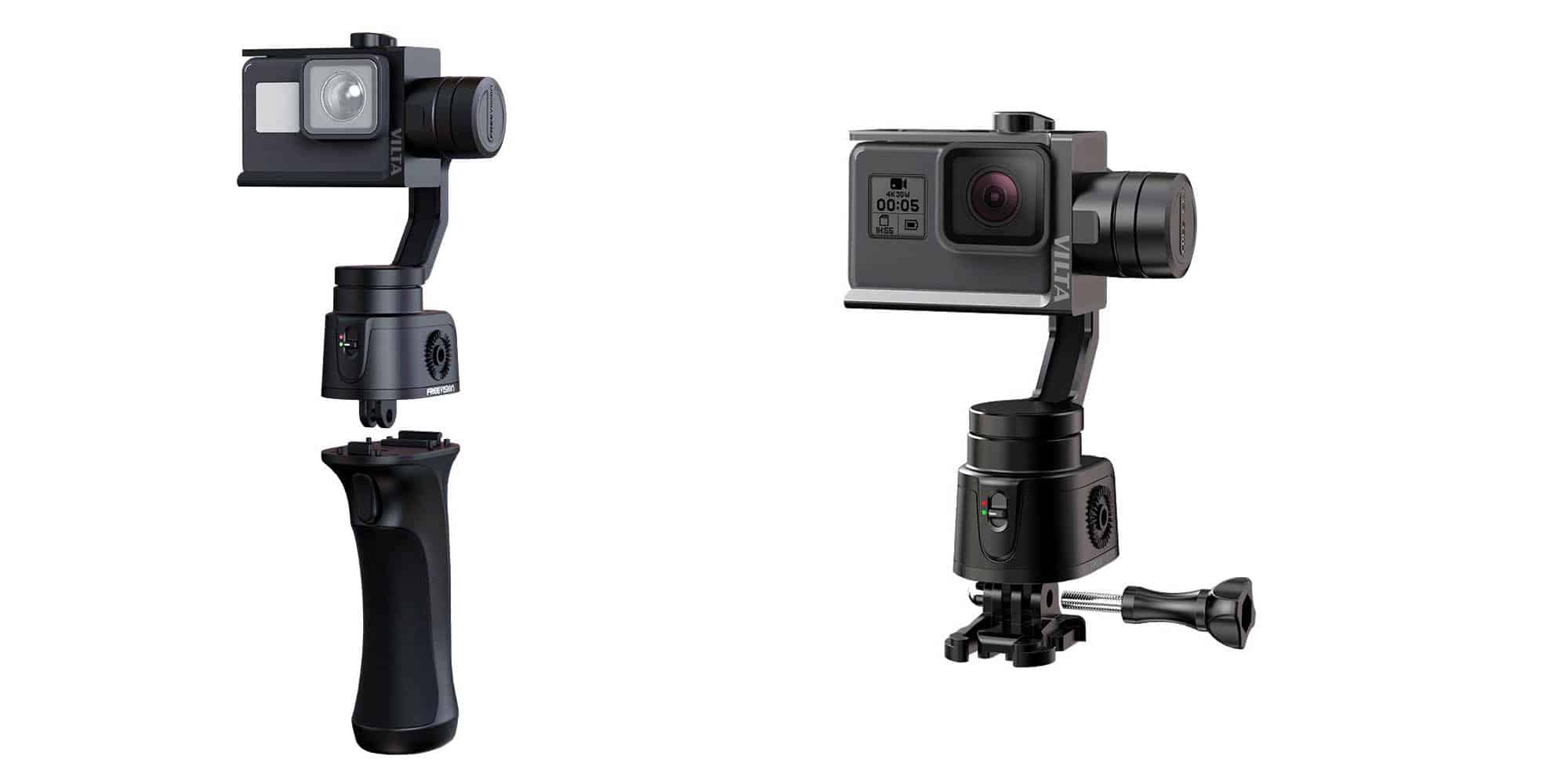Freevision impressed me with their Vilta-M gimbal for smartphones. It featured premium build quality at a very reasonable price point. The Freevison Vilta-G is a 3-axis motorized gimbal for GoPro/action camera gimbal and I’ve had the chance to test it out.
First Impressions

The Freevision Vilta-G comes packed in a semi-hard shell case which also includes a micro-USB charging cable and shoulder strap.
Like the Vilta-M, the Vilta-G feels well-built. The front and back rubber grips that line the handle make it very comfortable to hold in the hands.
As with pretty much any other GoPro gimbal, the Vilta-G features a metal, universal quarter-inch thread needle to connect it to various poles or tripods. A nice surprise is the addition of a rosette mount on the side of the gimbal that provides compatibility with even more accessories like custom DJI Osmo Mobile accessories.
The mounting procedure is very simple and straightforward. The Vilta-G’s frame housing is cut to fit the GoPro HERO5/6/7, making it a simple case of sliding the GoPro in. The included GoPro HERO3/4 frame housing needs to be used if you’re using an older GoPro model.
Using The Vilta-G As A Wearable Gimbal
One of the Vilta-G’s unique features is that it can be used as either handheld gimbal or a wearable gimbal. This is achieved by simply pressing the ‘PUSH’ button which releases the gimbal from its handgrip, leaving a wearable gimbal that is compatible with the GoPro mounting ecosystem.
This isn’t the first GoPro gimbal to do this, since the Removu S1 and (with some fiddling) GoPro Karma Grip can also be used in two different ways.
The Vilta-G is perhaps a superior 2-in-1 setup to the GoPro Karma Grip, but doesn’t execute things quite as well as the Removu S1. Firstly, detaching the handgrip on the Vilta-G leaves you with just a 350mAh battery which doesn’t last very long. Secondly, the form factor of the gimbal in its wearable form is a tall and not as well-suited to mounting as ‘true’ wearable gimbals like the Feiyu WG2X wearable gimbal.
With all that said, I can’t deny that the Vilta-G has a serious trick up its sleeve by being able to function as both a handheld and wearable gimbal. If you wish to record video with your GoPro both in your hands and worn, the Vilta-G is one of the very few options with that capability.
Controls
The Vilta-G is fairly simple to control. Aside from the power button, the main button you’ll be using is the trigger button at the rear of the grip which cycles through gimbal shooting modes.
The following mode locks the GoPro’s roll axis, meaning it will follow your movements in the pan and tilt axis while making sure the footage is smoothed out. Meanwhile, the locked mode will lock the GoPro in its current orientation, meaning it will counteract movements in all axes and stay locked on the target.
While you’ll typically be pointing the camera around using your hand, the Vilta-G features a joystick that can electronically adjust the pan and tilt. This is useful if you wish to make super-steady pan and tilt motions and don’t have much faith in your own hands to keep things steady.
The Vilta-G has a 360-degree range of motion in the pan axis and a tilt axis of -45° to 100°. This makes it superior to much of its competition in this respect, beating out the likes of the GoPro Karma Grip and Removu S1.
Performance
Stabilization performance is definitely one of the Freevision Vilta-G’s strong points. Comparing footage with other highly-rated gimbals like the GoPro Karma Grip and Feiyu G6, there is almost no difference.
Only when I compared footage to the GoPro Karma Grip when zoomed in at 20x could I notice a significant difference between the two. The GoPro Karma Grip is still the king of stabilization performance, but the Vilta-G is definitely one of the best performers out there among third-party gimbals.
Freevision App
While the GoPro has its companion smartphone app, to change various settings on the Vilta-G or control it remotely, you’ll want to download the Freevision gimbal app.
As with many other gimbal apps, the Freevision app is quite disappointing, with poor translations from Chinese and a poor user experience. I found it quite difficult to pair the app with the GoPro, but it magically started working after a few failed attempts.
Since Freevision gimbals aren’t as popular as gimbals from bigger third-party gimbal manufacturers like EVO or Feiyu, I wouldn’t count on the smartphone app seeing any considerable improvement.
Verdict
The Freevision Vilta-G is a great GoPro gimbal that performs well in every aspect. The fact that it has the versatility to be used as a wearable as well as handheld gimbal is the icing on the cake.
Unfortunately, it’s difficult to see which target Freevision are targeting given the Vilta-G’s price.
It doesn’t offer the same value proposition as the cheaper Feiyu G6 and is priced much closer to GoPro’s very own Karma Grip. While the Vilta-G does have superior battery life and is simpler to use as a wearable gimbal, the Karma Grip offers superior support, is part of the official GoPro ecosystem and has superior stabilization performance.
The Freevision Vilta-M had a big price cut, and if the Vilta-G is priced comparably to the Feiyu G6 I can confidently recommend the Vilta-G as a solid purchase. However, at its current price of $239.99, it feels a little overpriced.
Rating: 3.5/5
- SUPERIOR STABILITY: VILTA has the most advanced motor and servo control...
- Handheld Gimbal changes to a wearable gimbal with a quick release button....
- No more complicated calibration procedures, VILTA applies its own patented...
- NOISE REDUCTION: The motor response will be accompanied by some, but...
If you’re still looking for the perfect GoPro gimbal, check out my list of recommended GoPro gimbals.

